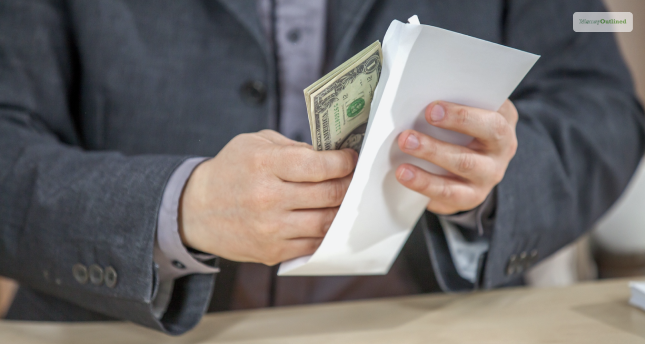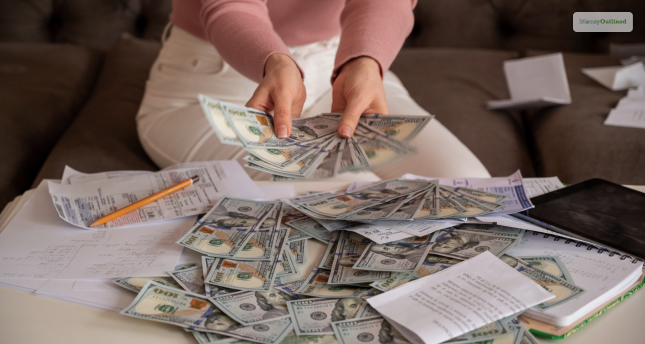Table Of Contents
- What Is Cash Stuffing?
- What Is The Process Of Cash Stuffing?
- How To Get Started?
- List Down All Your Spending Categories
- Make A Spending Limit For Each Of The Categories
- Create The Cash Stuffing Envelopes
- Spend Only With Your Envelopes
- Save The Leftover Cash
- Pros And Cons Of Cash Stuffing
- Pros
- Cons
- The Bottom Line
- What Is Cash Stuffing?
- What Is The Process Of Cash Stuffing?
- How To Get Started?
- List Down All Your Spending Categories
- Make A Spending Limit For Each Of The Categories
- Create The Cash Stuffing Envelopes
- Spend Only With Your Envelopes
- Save The Leftover Cash
- Pros And Cons Of Cash Stuffing
- Pros
- Cons
- The Bottom Line
What Is Cash Stuffing? How To Get Started?
While you may not consider it to be one, impulsive spending is a serious money issue. And needs an instant fix if you are planning to start saving soon. But how?
For a lot of us, spending money unnecessarily is a habit. We buy things we don?t even need just for the momentary satisfaction of it.
I have found myself multiple times wandering around Target, not even sure what to buy. But I just know that I have to spend some cash in order to detox from my regular life. This is an unhealthy habit and needs to be cured.
Therefore, if you want to start saving from today onwards, you need to start fixing a budget for yourself. Budgeting may seem a little challenging initially, but with time and discipline, it becomes a lot more accessible.
So, if you’re looking for an effective way to save those bucks, try out the budgeting technique that has gained quite a lot of attention on TikTok.
Yes, you guessed it right. It is the cash-stuffing method of saving money.
But what is cash stuffing? Is it really that new? Or is it only an updated name for yet another age-old process that the generation had made new?
Well, stay with me till the end of the article. And we shall find out every nook and crook of cash stuffing.
What Is Cash Stuffing?

While the name itself gives out the definition of this budgeting process.
Cash stuffing is a process where one stuffs cash in multiple sections as per their needs and requirements. Sounds familiar?
Because it is.
Cash stuffing is just the updated version of what is called Envelope Budgeting.
In cash stuffing, one sets aside cash in separate compartments for multiple spending categories. They only spend the amount they allow themselves to each month.
Cash stuffing is a well-defined budgeting system and has several benefits and drawbacks. You need to understand each of them well to participate in this budgeting system.
There is no use if you impulsively decide to take part in it only to flip back a couple of months later.
What Is The Process Of Cash Stuffing?

Cash stuffing is a process where you take the money you are supposed to spend each month, convert it into cash, and then stuff it into the compartments, envelope mostly. Each of these compartments represents a spending category, such as rent, gas, bills, groceries, etc.
You get to decide how much money you will be keeping in each of these compartments on a monthly or, in some cases, on a weekly basis. Then, you keep only the decided amount in the designated envelope and make sure you spend only the amount in the envelope for the entire time period.
Although you can easily use a budgeting app or a spreadsheet to maintain your cash-stuffing record, some people find it more effective when they are practicing it with physical money.
It is abstract to keep money at a bank, and you may not always be in a position where you can check how much you are left to spend at all times. On the other hand, if you need money for gas, and you open the Gas envelope and see you have $50 left, you would know exactly how much you can spend on gas without crossing your budget.
How To Get Started?

If I have already convinced you that cash stuffing is indeed an effective way to save your money, and you are considering starting one for yourself, these are steps that you need to follow.
List Down All Your Spending Categories
Note down all the areas where you spend your money in a given month or a time period. This will give you a clear picture of what compartments or envelopes you need to make that will include all your expense areas.
The categories you pick depend on you. But here are some of the common categories that most people include in their budget.
- Rent and bills
- Groceries
- Gas
- Dining/takeout
- Entertainment
- Clothing
- Travel
- Coffee
- Alcohol
- Home Decor
- Car maintenance
- Gifts
Make A Spending Limit For Each Of The Categories
Now that you are clear about the categories that you want to include in the envelopes, you need to set a spending budget for each of these envelopes.
The spending limit varies depending on one envelope to the other.
You may just open your bank statements and calculate, on average, how much you spend each month on each of the categories in the last couple of months.
This way, you will have a clear picture of what you generally spend on each of those categories. Accordingly, you can cut down or increase the limit as per your needs.
Create The Cash Stuffing Envelopes
After deciding on the categories and setting spending limits, it is time that you create the cash-stuffing envelopes. This is the step where you have fun and get as creative as you want.
There are no boundaries as to how you may create the envelopes. You may simply keep it in plain, boring white envelopes, or you can just spice it up a little by creating fun labels and decorative envelopes.
You may also use a ?budget binder,? as the TikTok folks like to call it, which helps in holding all of the envelopes in place to fit them in a purse or wallet.
Withdraw the money and stuff the envelopes.
Once all the creative and calculative steps are done, it is time that you make a total of how much you need and withdraw the cash from a bank or ATM.
Count the total and put it into each of the compartments as per your category limits.
Spend Only With Your Envelopes
This is where self-control and discipline come into play. To make this entire process successfully work, it is very important that you only spend what you keep in each envelope.
More than saving money, initially, it must be your goal to not run out of money within the first two weeks of the month. You must not spend money using any other sources like a credit or debit card. That ruins the whole purpose of the entire thing.
Also, you must try to stop yourself from transferring cash from one envelope to another. This way, you will run out of cash in the category from which you impulsively take out cash.
Save The Leftover Cash
Just because you have saved a considerable amount of money by the end of a budgeting period doesn?t mean that you will unnecessarily spend the money on things you do not need. Instead, try to save the cash that you are left with.
You can put the cash in a high-yield savings account. This way, your money will keep growing over time and can help boost your savings.
Pros And Cons Of Cash Stuffing

Here are the pros and cons of cash stuffing that you must know before you invest your time in it.
Pros
- Improves your money management skills: Money management is something that we severely lack these days. Impulsive buying is one of the biggest reasons why we cannot save enough these days. When we get limits as to how much we can spend each month, it makes us more aware and conscious of the ways in which we spend our money.
- Makes you mindful while you spend: When you spend cash, you are more aware of what you are spending and how much you are saving. This does not happen if you pay with credit or debit cards. Physical money is a lot more easy to track. For instance, if you are spending $100 from your grocery envelope and see that you are left with another $100, you would know exactly how or when to spend that amount so that you do not run out of cash. Also, when you pay physically, you feel more guilty about the money going away. It is psychological.
- You may pay off debts a lot faster: Cash stuffing helps you sort your money based on your priorities. Therefore, when you have debts to pay off, cash stuffing is a great practice to participate in, as paying those debts off will be one of your biggest priorities, and you will have a separate compartment dedicated to your debts. This way, you will not forget how you owe to whom and won?t make a delay in paying off.
- Makes you aware of your financial conditions: Can you honestly tell me that you open your bank statement every time you swipe your card? No right? No one does it because none of us have the time. This results in us being totally unaware of our financial conditions. I fell under the same pattern. I made multiple payments directly through debit and never once opened my account to check how much I was left with. This landed me in serious financial trouble multiple times. If you are cash stuffing, you can easily see how much cash you are left with each time you open the envelopes. This way, you would know how to cut down on your spending if it is at all required to get through the whole budgeting period.
Cons
- You have to make frequent trips to the bank: This, in fact, is a troubling process. Honestly speaking, I do not remember the last time I went to the bank. Everything I do is online and does not need me to visit the bank every now and then. But, if you are cash-stuffing, you will have to visit the bank or an ATM to withdraw cash at the end of each budgeting period. For monthly budgeting periods, the hassle is still comparatively less, but if you follow a weekly budgeting period, you will have to visit the bank at least four times a week.
- Cash stuffing may be quite impractical for certain purchases: While it is quite helpful to many, I certainly believe that cash stuffing is actually quite impractical for certain purchases. It may just be the best thing to do if you are saving money on gas or groceries, but it is quite impractical for rent or other mandatory expenses.
- There is always a risk of theft or robbery: Do you really think that you can walk around in the streets of America with wads of cash and never ever catch the eye of a thief or robber? The chances are rare. With crime rates going high, there is likely any chance that you are safe with that much cash in hand. Your house, too, is not the safest place to store cash. You never know who would break in and just steal away the money that you so carefully have been saving.
- You do not earn any reward or interest, which you could easily earn at a bank or any other financial institution: Keeping the money in a bank is much more beneficial than keeping it at home. At least, in a bank or in a financial institution, the money will earn interest or certain rewards that will help it grow over time. Keeping money at home, indeed, is a foolish idea as the money just lies around without bringing you any profit out of it.
The Bottom Line
Now that you know what is cash stuffing and how, to begin with, I would suggest that this is the perfect time for you to get on board with it.
There is nothing called the best time for it. Whenever you start is the best time. There is no perfect time for saving money. The earlier you start, the better.
Initially, it may seem tough, and you may find yourself getting diverted, but that is normal. Everyone goes through it. It is never easy to break out of a pattern that you have been following for years.
But as they say, everything has its first. And this may just be yours.
Thank you for staying with us for this long. I am hoping you got all the insights you were looking for. If there is anything else that you might want to add, please feel free to drop a comment below.
Continue Reading:











Leave A Comment